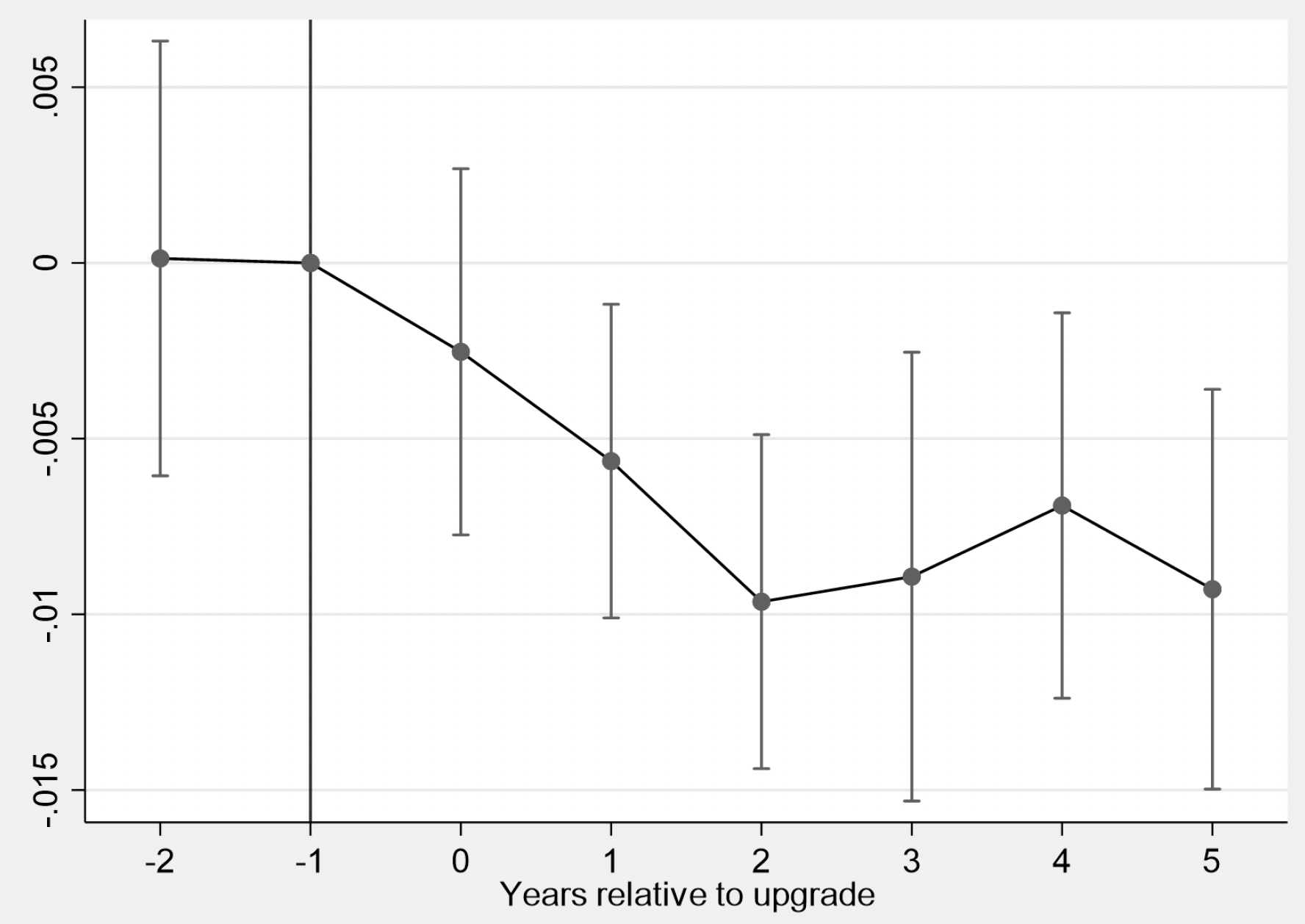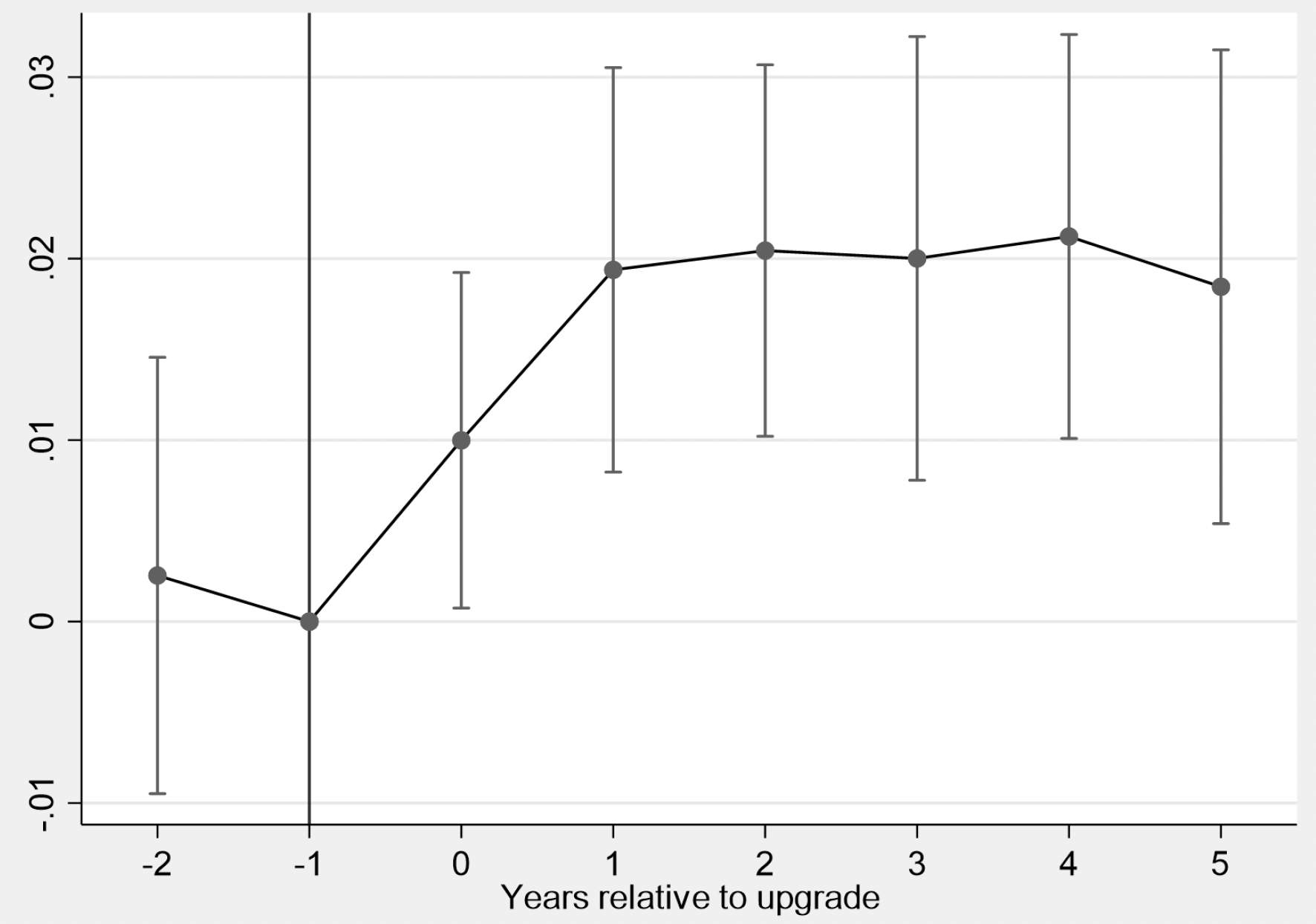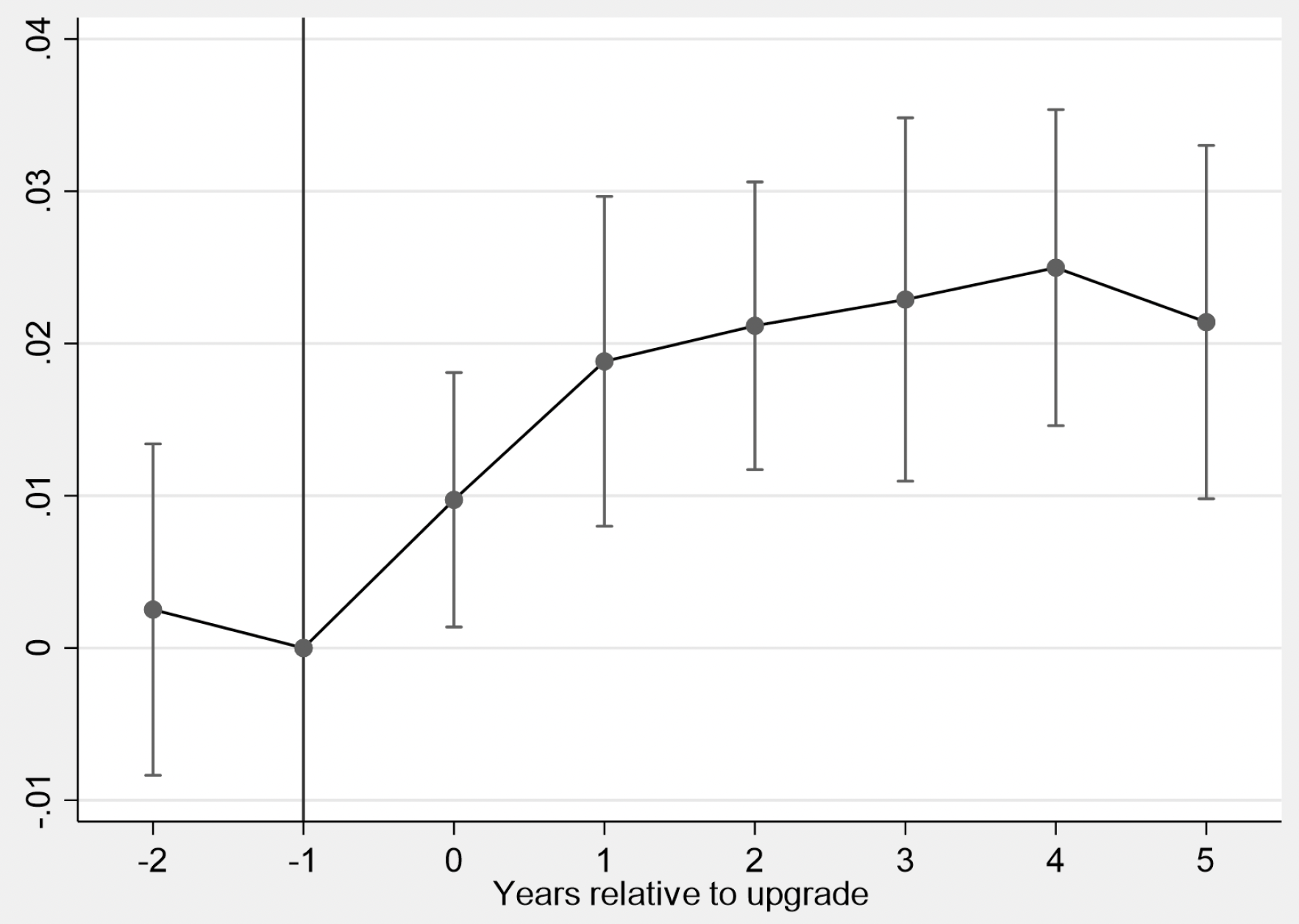
Highway construction in India improved productivity by inducing firms to focus on products in which they are most efficient
Transportation costs are one of the most cited obstacles by firms in developing countries. In the World Bank’s Enterprise Surveys, about 20% of firms in developing countries identify transportation as a major constraint (World Bank 2021). According to the World Economic Forum’s Global Competitiveness Index (GCI), which ranks 137 countries, the median ranking for quality of roads is 28 for high-income countries, compared to 81 for upper-middle-income countries, 85 for lower-middle income countries and 113 for low-income countries (World Bank 2020)...
While much attention in the literature has been given to international trade costs, there has been comparatively less work on intranational trade costs and their potential to influence firm productivity and, ultimately, economic growth. Recent work has highlighted the existence of high transportation costs in developing countries, which can hinder intranational trade (Atkin and Donaldson 2015). As previous research has also established an increase in firm productivity as one of the gains from trade (Atkin et al. 2019, Shu and Steinwender 2019), reducing barriers to intranational trade in developing countries by reducing transportation costs may further help increase firm productivity.
How can a reduction in trade costs affect firm productivity?
There are several channels through which reduced trade costs can increase firm productivity. We focus on the following channel posited by recent trade models. A reduction in trade costs increases the competition faced by firms and forces them to drop the products in which they are least efficient and focus on the products in which they are most efficient (Eckel and Neary 2010, Bernard et al. 2011, Nocke and Yeaple 2014, and Mayer et al. 2014). In line with this theory, in response to a fall in trade costs, we should expect to observe firms reducing the number of products they make to focus on the ones in which they are most efficient, which would result in an increase in their productivity. This pro-competitive effect of trade is particularly important in developing countries, which tend to face a multitude of barriers that limit competition, including transportation costs. According to the GCI, the median ranking for intensity of competition in local markets is 37 for high-income countries, compared to 68 for upper-middle-income countries, 86 for lower-middle-income countries and 107 for low-income countries (World Bank 2020).
Upgrading India’s longest highway
In a new study (Abeberese and Chen 2021), we provide evidence on the productivity impact of a reduction in intranational trade costs by analysing the effect of a fall in transportation costs induced by a highway project in India. Road transportation accounts for the bulk of freight and passenger movement in India. However, rising demand coupled with an inadequate supply of roads had led to congestion and poor road quality. Inadequate highway infrastructure had long been considered one of the main constraints to economic growth in the country (World Bank 2001).
In 2001, the Indian government began upgrading the Golden Quadrilateral (GQ), a major highway network connecting four large cities: Delhi, Mumbai, Kolkata, and Chennai. The government sought to upgrade the highway network by widening roads from two to four and six lanes and constructing medians, service lanes, overpasses, underpasses, and bypasses. The GQ is the longest highway in India and the fifth longest in the world. Some studies have provided evidence that the GQ project led to a substantial reduction in trade costs within the country (Datta 2012 and Asturias et al. 2019).
Assessing the impacts of the Golden Quadrilateral upgrade
Analysing the causal impact of roads can be challenging because the placement of roads is not random and is usually driven by some economic outcome. For instance, policymakers may decide to improve road quality specifically in areas with lagging economic activity in order to promote growth. Alternatively, policymakers may decide to improve road quality specifically in areas that are doing well because they may be better positioned to take advantage of the growth opportunities offered by the improved roads. Thus, any changes in productivity following road construction cannot be necessarily attributed to the construction given the underlying economic differences that may have already existed.
One way to address this challenge is to focus on areas that happened to have been connected to these roads by chance due to them lying in between the areas that were the targets of the road construction. In the context of the GQ project, we consider districts other than the targeted districts of (Delhi, Mumbai, Kolkata, and Chennai), which we refer to as ‘non-nodal’ districts, as having been connected to the highway by chance. We, therefore, assess how firm productivity in the non-nodal districts changed with the fall in trade costs, proxied by the district’s distance to the GQ.
The Golden Quadrilateral upgrade increased firm productivity in India
Figures 1 to 3 show estimates of the differential change in firm outcomes with proximity to the GQ before and after the GQ upgrade. In line with the assumption that the non-nodal districts were connected to the GQ by chance, there is no differential change in firm outcomes prior to the GQ upgrade. Figure 1 shows that, following the GQ upgrade, the number of products fell for firms closer to the GQ relative to those farther away.
Figure 1 Effect on the number of products

Note: The figure presents estimates from the authors’ analysis of the dynamic effects of the Golden Quadrilateral on the number of products made by firms using data from the Indian Annual Survey of Industries. The vertical lines represent 90% confidence intervals.
Further, we find that the products dropped by a firm were the ones that accounted for the lowest shares of the firm’s output, suggesting that firms were dropping the products in which they were least efficient. Consistent with this result, Figures 2 and 3 show that firm labour productivity and total factor productivity increased for firms closer to the GQ relative to those farther away. We also find that these effects were strongest in industries that are most reliant on road transportation, suggesting that the changes were driven by the GQ upgrade. In line with the GQ upgrade reducing trade costs and increasing competition such that firms focused on the products in which they were most efficient, we find a differential decrease in product prices in districts closest to the GQ.
Figure 2 Effect on labour productivity

Note: The figure presents estimates from the authors’ analysis of the dynamic effects of the Golden Quadrilateral on firm labour productivity using data from the Indian Annual Survey of Industries. The vertical lines represent 90% confidence intervals.
Figure 3 Effect on total factor productivity

Note: The figure presents estimates from the authors’ analysis of the dynamic effects of the Golden Quadrilateral on the firm total factor productivity using data from the Indian Annual Survey of Industries. The vertical lines represent 90% confidence intervals.
Implications for more effective transportation policy
By focusing on intranational trade, we highlight how trade even within national borders can generate competitive pressure and productivity gains. Our findings provide an impetus for addressing barriers to intranational trade. Our results show that reducing transportation costs can lead to productivity gains by inducing firms to focus on the products in which they are most efficient. Given the evidence that differences in economic growth across countries are primarily driven by productivity differences, our study sheds light on the potential for improvements in transportation infrastructure to catalyse economic growth.
References
Abeberese, A B and M Chen (2021), “Intranational Trade Costs, Product Scope and Productivity: Evidence from India’s Golden Quadrilateral Project”, Journal of Development Economics, forthcoming.
Asturias, J, M Garcia-Santana and R Ramos (2019), “Competition and the Welfare Gains from Transportation Infrastructure: Evidence from the Golden Quadrilateral of India”, Journal of the European Economic Association 17(6): 1881-1940.
Atkin, D and D Donaldson (2015), “Who’s Getting Globalized? The Size and Implications of Intranational Trade Costs”, NBER Working Paper No. 21439.
Atkin, D, D Donaldson, I Rasul, M Teachout, E Verhoogen and C Woodruff (2019), “Firms, Trade and Productivity”, IGC Evidence Paper.
Bernard, A B, S J Redding and P K Schott (2011), “Multi-Product Firms and Trade Liberalization”, Quarterly Journal of Economics 126(3): 1271-1318.
Datta, S (2012), “The Impact of Improved Highways on Indian Firms”, Journal of Development Economics 99(1): 46-57.
Eckel, C, and J P Neary (2010), “Multi-Product Firms and Flexible Manufacturing in the Global Economy”, Review of Economic Studies 77(1): 188-217.
Mayer, T, M J Melitz, and G I P Ottaviano (2014), “Market Size, Competition, and the Product Mix of Exporters”, American Economic Review 104(2): 495-536.
Nocke, V, and S Yeaple (2014), “Globalization and Multiproduct Firms”, International Economic Review 55(4): 993-1018.
Shu, P, and C Steinwender (2019), “The Impact of Trade Liberalization on Firm Productivity and Innovation”, Innovation Policy and the Economy 19(1): 39-68.
World Bank (2020), “World Bank TCdata360 Database” (accessed 15 August 2020).
World Bank (2001), “India's Central Government Reduces Travel Time and Road Accidents On Major Highway with US$589 Million World Bank Loan” (accessed 20 August 2018).
World Bank (2021), “Enterprise Surveys”.


